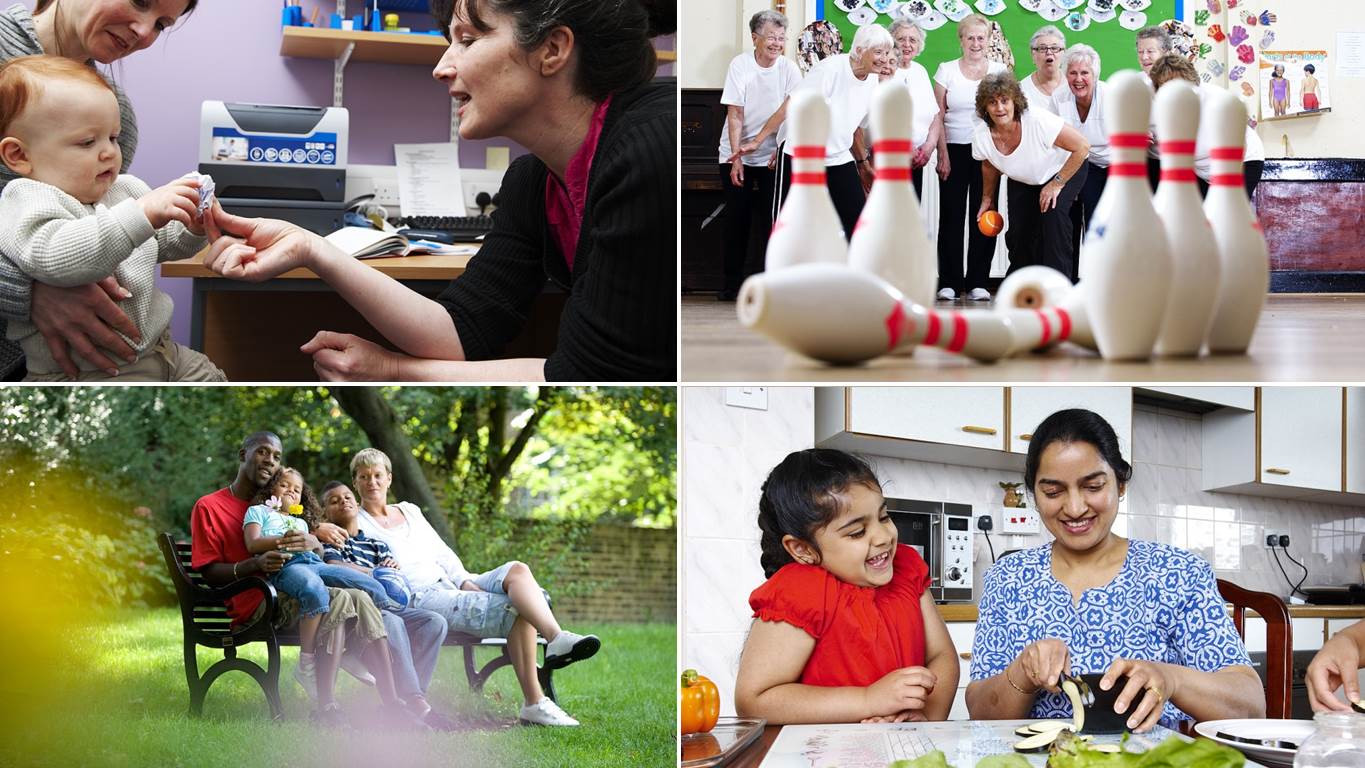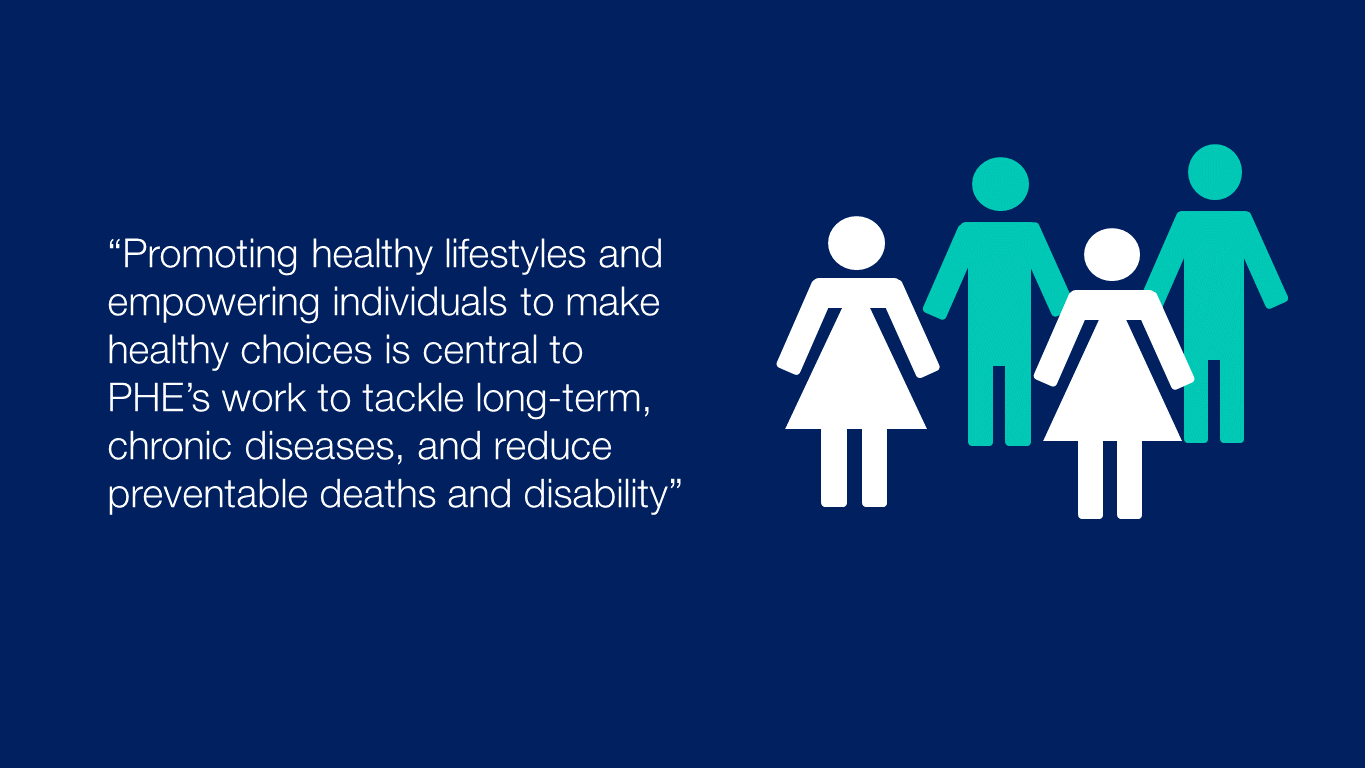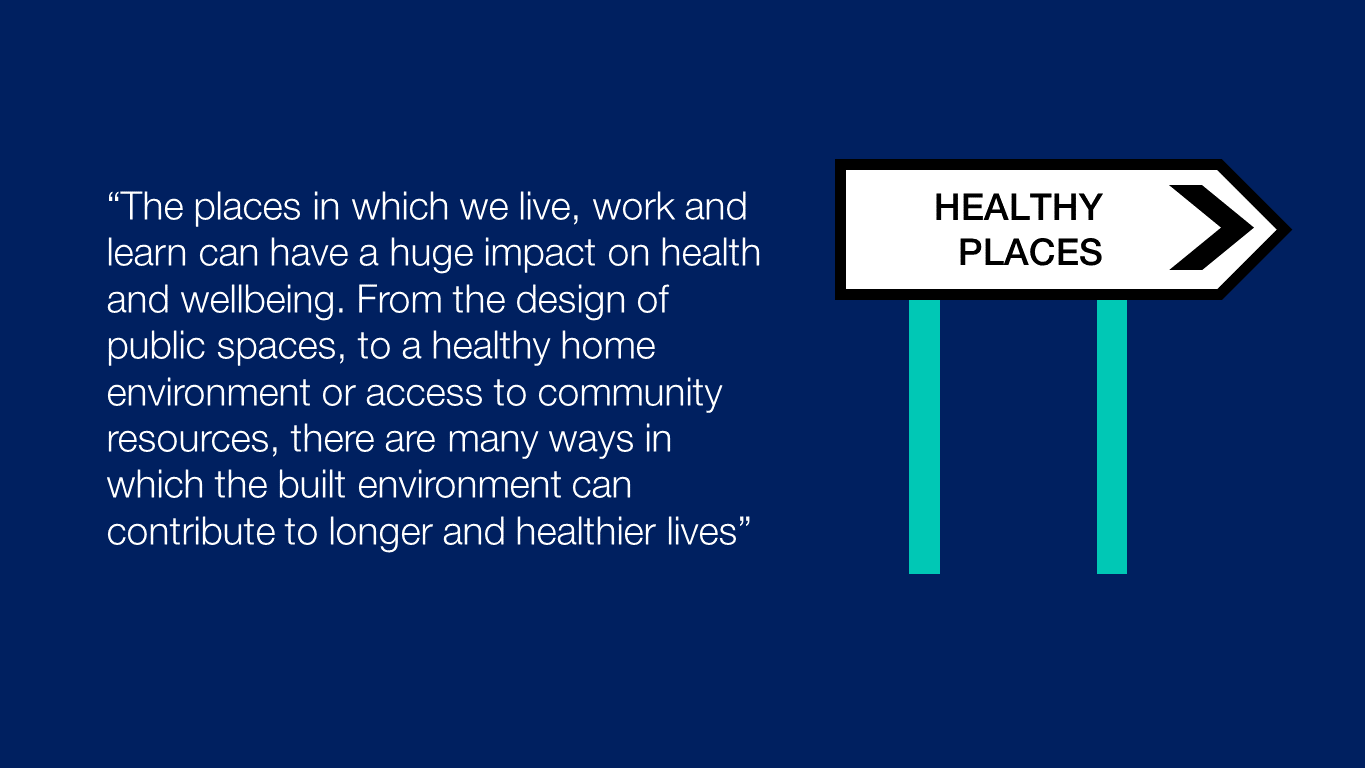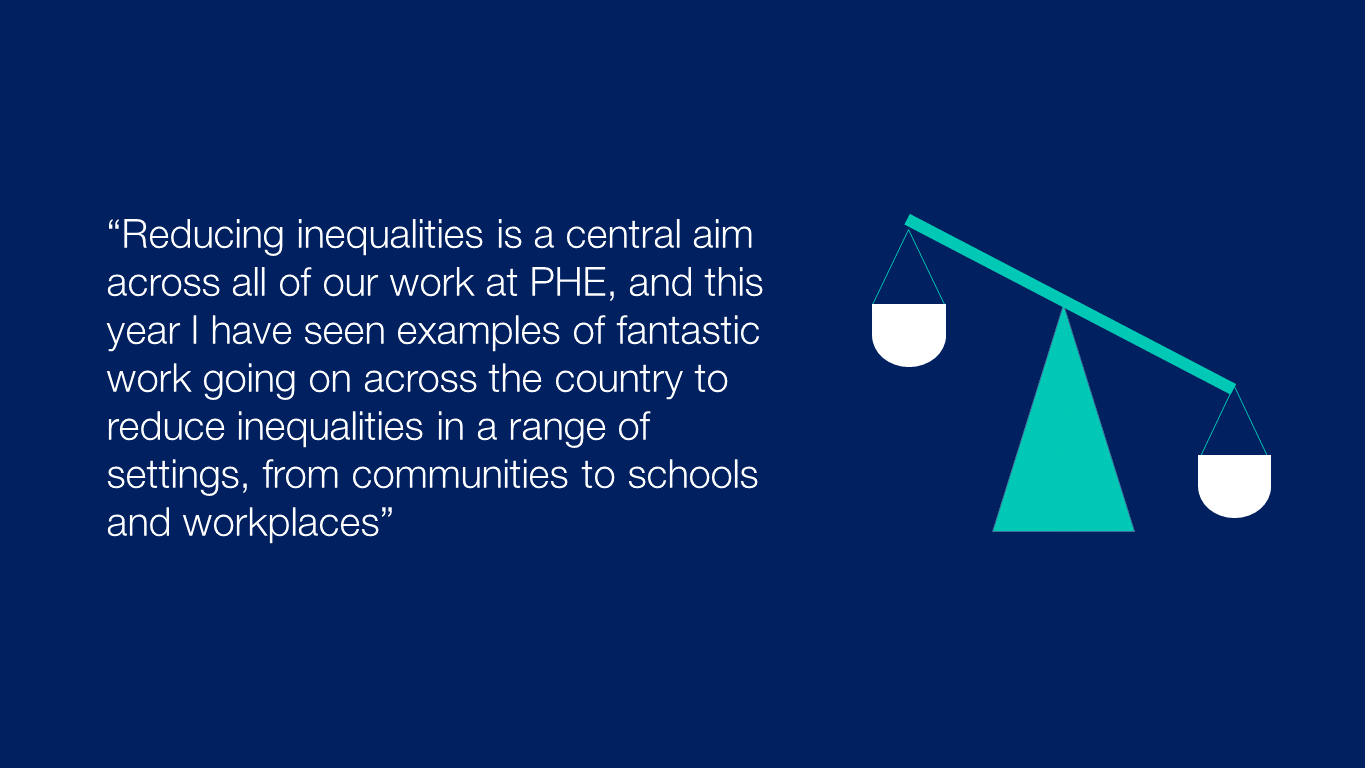
2015 was a busy year. I wanted to reflect on some of the many highlights of our national work in improving health and promoting wellbeing. This blog captures just some of the fantastic work being done by health and wellbeing colleagues working nationally in partnership with teams across PHE, with the NHS, local government, NGOs and health care professionals across the country.
This work is just part of a broad range of activities happening across PHE. Without our partnerships both inside and outside the organisation these achievements would not have been possible. I look forward to building on these relationships in the year ahead.
This year we have continued our focus on supporting people to make healthy choices through our health marketing campaigns on eating well, staying active and reducing harmful behaviours such as smoking. We’re also working to promote good mental health and to ensure people can stay healthy into their later years.
We’re also helping local authorities maintain healthy environments for their local populations – in communities, homes and workplaces.
And we’re there working alongside health services and local providers, supporting screening and testing services to prevent disease and promote early diagnosis, and ensuring every contact with individuals through care settings, such as pharmacies, involves the promotion of healthy lifestyles.
We have also helped to improve the health of populations globally, sharing our knowledge and also learning from our international public health colleagues.
All of PHE’s achievements in 2015 have helped us to move forward towards our goal of improving health and reducing health inequalities for people in England. Here is just a selection:

Healthy people
Many of the conditions that cause the greatest burden on health in England are preventable, caused by unhealthy behaviours such as smoking and eating and drinking to excess. Promoting healthy lifestyles and empowering individuals to make healthy choices is central to PHE’s work to tackle long-term, chronic diseases, and reduce preventable deaths and disability. We want all people living in England to be healthy people, and this year we have taken some significant steps towards this goal.
In October we published our report Sugar reduction: the evidence for action, setting out a broad range of measures to tackle the overconsumption of sugar. There is a huge opportunity for change in the way that high-sugar products are sold and advertised, particularly to children, and we will continue to input into the government’s child obesity strategy, expected next year.
We’ve also published evidence on dietary intake, a draft review on vitamin D and reviewed healthy eating messages, and supported wider improvements in diet through healthier and more sustainable catering. This all contributes to the whole system approach to reducing obesity and related ill health and underpins our Change4Life campaign.
It’s just over a year since we launched our Everybody Active Every Day framework, and at the start of 2015 we produced a set of free e-learning resources, produced with BMJ Learning, to support clinicians to integrate physical activity into the prevention and treatment of long term conditions. And we now have 16 clinical champions working across six regions to deliver peer to peer education for doctors on integrating physical activity into clinical care.
In October we published a guide for schools and local authorities on actions they can take to help more children be more physically active. The resource, which has cross Government support, will help children and parents be more active and contribute to our work on reducing child obesity.
This year, poor oral health has been recognised as a priority under PHE’s Best Start in Life programme. A third of our children have tooth decay at 5 years old and dental extractions under general anaesthetic are the most common reason for admission to hospital for 5-9 year olds. In July we ran an oral health roundtable with a number of stakeholders to develop our joint ambition for every child to grow up free from tooth decay. We also published the first ever national survey on the oral health of children in special support schools this year, which highlighted inequalities in both health and treatment services. Oral health has been integrated into our work on sugar reduction, and our latest factsheet explores the relationships between dental caries and obesity in children.
We are also currently working with seven local authorities to learn practical lessons from local diabetes programmes, and to co-design and implement a national NHS Diabetes Prevention Programme. I look forward to sharing much more about this exciting work next year.
Addressing health harms
As well as encouraging healthy behaviours, we are also tackling harmful behaviours. This year we have provided the Home Office with public health support for its Local Alcohol Action Area programme, which aims to reduce alcohol-related crime and disorder, and negative health impacts caused by alcohol. New patterns of drug use and associated harms continue to emerge, while drug-related death rates have continued to rise. PHE is supporting local areas with a series of resources and briefings on issues such as overdose and hepatitis C, and at the beginning of the year we announced £10 million of funding for projects across England to help people recover from drug and alcohol addiction.
Smoking is the largest single cause of health inequalities in England. Our evidence update on e-cigarettes sparked plenty of debate across the media and among health professionals earlier this year, and provides a firm foundation for the development of future policy and practice on e-cigarettes, particularly as a potential support for smokers to quit completely.
This year, we have also worked with partners across England to address smoking in high prevalence and high priority groups, including people with mental health issues and pregnant women.
At PHE, we are always exploring new and creative ways to help people make healthier choices, and creating evidence to support these methods. Behavioural insights trials this year include work to reduce antibiotic prescribing by GPs, to increase the uptake of children’s weight management services, and to encourage flu vaccination – look out for the published results of these trials next year.
No health without mental health
Improving mental health underpins all of our work, and in March, we brought together over 300 local and national partners to engage in a public mental health summit. In August we established the National Prevention Alliance for Mental Health, bringing together over 30 national organisations that have committed to champion the prevention of mental illness.
We have also developed a set of tools and resources to help local authorities and health professionals understand and work effectively to prevent suicides in their areas. This includes a local suicide prevention profile which presents a range of data on suicide and related risk factors.
We also continue working to promote healthy ageing for older people. This year we produced publications with partners on a range of issues, including reducing your risk of dementia, falls prevention and a guide to healthy ageing. I’m delighted that we have now recruited 1m dementia friends and this fantastic programme has now been transferred to Alzheimer’s Society who will continue to support and train volunteers.
Creative campaigns
In order to help change the behaviours of individuals, families, workforces, communities and businesses, so that it becomes easier for us all to live healthier, longer and more fulfilled lives, we develop impactful creative campaigns each year, based on insight into why people behave the way they do and the needs of local communities. Our campaigns in 2015 included Dry January, Stoptober and Change4Life.
Our Change4Life ‘10-minute shake-up’ initiative helps children to reach the recommended 60 minutes of physical activity a day by breaking it up and providing a range of 10 minute activities to do throughout the day. During this year’s campaign we engaged with 700,000 children to help them reach the recommended hour a day.
Stoptober offers people the chance to get together with friends to stop smoking for the month of October. Those that reach the 28 day goal are five times more likely to quit for good. This year, more than 215,000 smokers signed up to the campaign.

Healthy places
The places in which we live, work and learn can have a huge impact on health and wellbeing. From the design of public spaces, to a healthy home environment or access to community resources, there are many ways in which the built environment can contribute to longer and healthier lives.
I’m very pleased to see significant and widespread uptake of the guide we published this year with NHS England on community-centred approaches to health and wellbeing. The guide is there to support local commissioning and planning, and we continue to work with our partners to build the evidence and share learning from local communities.
This year, our Healthy People, Healthy Places programme hosted a conference on housing and public health, in partnership with the King’s Fund. At the conference we launched a series of new resources to promote joint working by local professionals – from environmental health and housing to allied health, public health and social care – in order to integrate housing as a means to improve health outcomes and reduce health inequalities.
We were also very pleased to work with the Chief Fire Officers Association, NHS England, the Local Government Association and Age UK to highlight opportunities for fire and rescue services to improve health and well-being. In three pilot areas including Greater Manchester, Staffordshire and Gloucestershire, we’ll be working with fire and rescue services to demonstrate the impact of their interventions to reduce issues such as falls, cold homes, social isolation and flu and their impact on winter related illnesses.
And we have been accelerating our work with employers to build on the launch of the national standard for the workplace wellbeing charter in 2014, supporting local areas to develop their local charter schemes and working with established schemes to encourage more businesses to use the charter to improve workplace health.

Healthy services
In order to improve health and tackle health inequalities, we need to work very closely with professionals across the NHS and social care services that treat and care for members of the public every day. We recognise the need to engage a wide range of professional groups to improve the public’s health, such as allied health professionals, pharmacists, nurses and dentists to develop their public health capacity.
For example, 1.2 million people visit community pharmacies every day, presenting an enormous opportunity to promote health at a local level. I’m delighted that 1,850 pharmacies have now been awarded the Healthy Living Pharmacies (HLP) accreditation, or are on the way to being accredited. PHE is developing an HLP implementation resource guide for commissioners and providers, and next year we will publish a new report, Pharmacy supporting the public’s health in England, in partnership with the Royal Society for Public Health.
Next year, we will be providing local authorities with knowledge and intelligence on their local area through our new Improvement HUB, as well as tools, guidance and evidence across key topics to support effective commissioning.
In the 2014/15 financial year, an additional 100,000 people received an NHS Health Check compared to the previous year. Health checks provide us with a tremendous opportunity to target the leading behavioural and physiological risk factors driving premature death, disability and health inequalities in England.
We have also continued our work on screening, including screening for breast and bowel cancers, and screening in pregnancy and newborn babies. Since January 2015, our screening quality assurance teams have visited more than 65 screening services around the country to ensure services are safe and help to resolve any problems.
In November, we were pleased to announce the launch of the first national HIV home-sampling service for people at high-risk of acquiring HIV. New PHE figures show that around 17% (18,100) of people with HIV are unaware and at risk of unknowingly passing on the virus to others. This new service encourages people at risk to find out their HIV status, using our free kits, so they can get the best care for themselves and partners.
We continue to work with local government and other partners to Make Every Contact Count – ensuring every contact with a patient or member of the public is seen as an opportunity to encourage healthier lifestyles to improve health and wellbeing. The national MECC advisory group will be launching a suite of products at a national MECC conference in January 2016.

Global health
As well as improving and protecting health at home, PHE has the skills and expertise to contribute towards addressing the global health challenges that we face and to reducing global health inequities.
The risk of Ebola to the UK public continues to be very low compared with key workers arriving from Ebola affected countries. Over the past 12 months PHE has established the world’s first Returning Workers Scheme (RWS) to coordinate the return of 2,756 key workers from West Africa, nearly half of whom have had the highest risk of exposure. The team is now sharing lessons with colleagues at the World Health Organization and the USA Centre for Disease Control, and presented to the House of Commons Science and Technology Committee so that the model can be integrated into future international responses.
We also continue to share valuable knowledge and expertise with other countries around the world, building international relationships of mutual benefit. This year we are working with Mexico on teenage pregnancy and obesity, and next year, we will develop collaborative working with China on sugar, salt and HIV prevention.

Health equity
Reducing inequalities is a central aim across all of our work at PHE, and this year I have seen examples of fantastic work going on across the country to reduce inequalities in a range of settings, from communities to schools and workplaces.
We know there is a strong link between work and wellbeing, yet for too many people, living with a long-term condition or disability has become a barrier to employment. PHE is working with the Joint Health and Work Unit and NHS England to close the employment gap for people with disability and long-term conditions, and our new practice resource on Promoting good quality jobs to reduce health inequalities demonstrates the opportunities for local partnerships to promote better jobs, support better health and help reduce health inequalities in their communities.
Our report No health without justice, no justice without health, published in October, explains how tackling health inequalities in the prison population can help to address wider health inequalities benefiting both those in prisons and wider society. This year we have identified shared priorities and agreed shared work programmes with the National Offender Management Service, Home Office Immigration Enforcement and the Youth Justice Board to address the needs of people in contact with the justice system.
Our new written and video case studies powerfully demonstrate the opportunities for local partnerships to make a difference to people’s lives – to help more people into employment, reduce social isolation, and build people’s capacity to improve their own health and wellbeing. People like Mark, whose mental and physical health was dramatically improved when he joined a local work placement scheme.
These stories tell a few of the many achievements of 2015 and illustrate some of the ways in which we are collaborating with our partners to accelerate health impact. As we prepare to begin a new year we commit to building upon our accomplishments, strengthening our partnerships and learning from the lessons of the past year. We’ve seen a lot of important progress that’s worth remembering.
